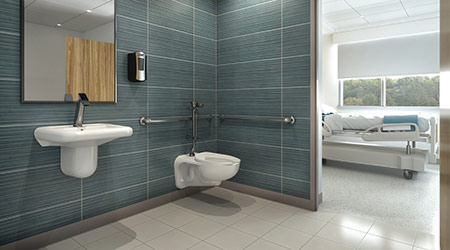Controlling bacteria and the spread of infections is a top priority across all restroom environments. But there is perhaps no other demographic with a greater need for bathroom fixtures aimed to minimize the effects of these diseases than that of healthcare facilities.
Restrooms in these environments are the perfect storm for the spread of infectious disease, as they not only serve patients who tend to be increasingly prone to disease-causing organisms, but deliver water between 77 degrees Fahrenheit and 108 degrees Fahrenheit — the exact temperature that bacteria thrives in.
The results are staggering. Not only have studies conducted by the United States Centers for Disease Control and Prevention (CDC) shown that U.S. hospitals report 1.7 million healthcare-acquired infections (HAIs) each year, but that there have also been an alarming 99,000 deaths due to the infection during their hospitalization. Not only that, but HAIs are also plaguing healthcare facilities’ bottom line. Aside from the many lives the infections have taken, HAIs cost hospitals $20 billion each year. There are three primary ways that patients contract HAIs — coming into contact with medical workers and other patients, ingesting infected water and inhaling infected water vapor — with almost half of HAIs caused by infected water.
To combat the outbreak of HAIs, healthcare facilities are beginning to strategically implement smart restroom design by specifying faucets, sinks, flushometers, toilets and urinals that are specifically manufactured for hands-free operation, lending themselves perfectly to the creation of a sanitary environment.
Proper hygiene is in our hands
Proper hand-washing is the single most effective means of preventing the spread of pathogens. Despite this universal truth, people do not always practice the correct technique, prompting restroom product manufacturers like Sloan to combat the spread of HAIs with hygiene-friendly products.
Faucets: The advent of touch-free faucets — with sensors to active and shut off the flow of water — has rendered faucet handles obsolete. Not only does handle-free operation remove a point of contact for spreading harmful bacteria across multiple users, but also promotes water conservation. Designed to operate for a pre-determined amount of time, hands-free faucets use approximately 1 gallon (3.8 L) less water per use than a manual faucet.
With the universal importance of proper handwashing — especially in a hospital — faucets need to cater to getting hands washed in the cleanest possible environment. While touchless faucets are an obvious alternative to minimize contact with the surfaces where germs breed, automatic flush features also avoid stagnant water in pipes while gooseneck spouts make it easier for the user to wash not just hands, but forearms as well. Faucet features like LCD displays guide users through handwashing recommendations. Additionally, laminar flow faucets keep water from mixing with germ-filled air while minimizing splashing.
Sinks: First and foremost, sinks in healthcare environments should be designed to get water down the drain quickly with as little splashing as possible. Deep sinks with offset drains prevent contaminated water from splashing, while antimicrobial coatings on high-quality vitreous china, stainless steel and solid surfaces — ideal materials for healthcare sinks — work to prevent germ growth on these surfaces.
Toilets and Urinals: Specifying fixtures that are easy to clean and maintain is an important aspect to keeping toilets and urinals free of germs and bacteria, while also minimizing contact between germs and people. Wall-mounted toilets make floor cleaning faster and more effective, while hydrophobic (water-repellent) and oleophobic (oil-repellent) properties can be incorporated into glazes for vitreous china toilets and urinals to impact the surface at a nanoscale level. Not only does this make the fixture easier to clean, but keeps it cleaner for longer.
Flushometers: Much like toilets and urinals, flushometers are a primary origin of the HAI epidemic. Touchless sensor flushometers not only reduce germ-spreading contact, but work to conserve water. Sensor flushometers are now reducing water volume by up to 30 percent and even automatically initiating a 1.1 gpf or 1.6 gpf flush based on how long the user remains in range of the sensor. Healthcare facilities like Rush University Medical Center and Elmhurst Hospital in Illinois are just two of the many hospitals across the country integrating bedpan washers into toilets to minimize the backsplash of infected water. While cleaning bedpans, healthcare professionals are often exposed to unwanted backsplash, but innovative bedpan washing systems allow for a safer and more sanitary alternative.
By specifying these types of hygiene-friendly fixtures, mixed in with the right hand-washing habits, healthcare facility restrooms will start becoming the solution — and not the problem — in regard to healthcare-acquired illnesses.
Mark Lawinger, BSME, MBA has been working in product management for Sloan for more than 25 years.

 UF Health Hospitals Rely on Green Globes to Realize Their Full Potential
UF Health Hospitals Rely on Green Globes to Realize Their Full Potential How Healthcare Facilities Can Be Truly Disaster-Resilient
How Healthcare Facilities Can Be Truly Disaster-Resilient TriasMD Breaks Ground on DISC Surgery Center for San Fernando Valley
TriasMD Breaks Ground on DISC Surgery Center for San Fernando Valley Bigfork Valley Hospital Falls Victim to Data Breach
Bigfork Valley Hospital Falls Victim to Data Breach AI-Driven Facilities: Strategic Planning and Cost Management
AI-Driven Facilities: Strategic Planning and Cost Management